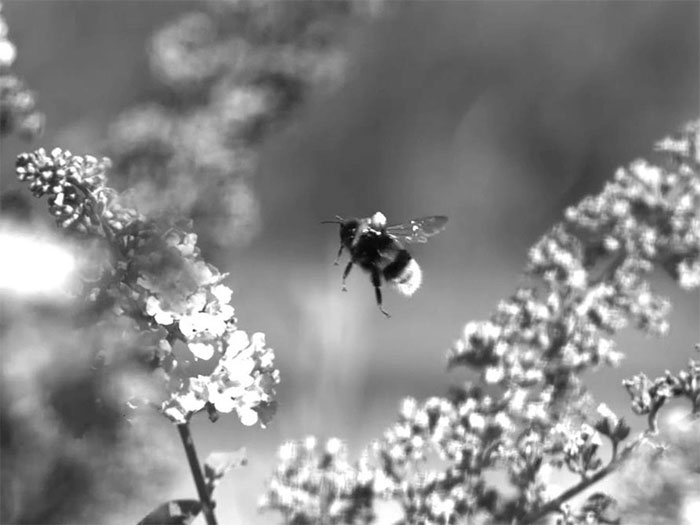Insect monitoring system of Vietnamese PhD
With the ability to track insect behavior at high speed, the system helps research on insect population decline, biodiversity or develop insect-inspired robots.
Recently, Dr. Vo Doan Tat Thang, University of Queensland, Australia and colleagues at the University of Freiburg, Germany published an article in the field robot category in the journal Science Robotics , opening a new step forward in insect research that has so far been limited by spy devices.

Photo of a hornet preparing to land captured by the FLO device with integrated high-speed camera - (Source: Straw Lab).
Insects have long been recognized as important to global ecosystems, economies, and health. Studying insects in their natural environments can yield important insights into their behavior and habits. However, filming insects in their natural environments is challenging due to their small size and extremely fast movements.
Due to the lack of suitable recording technology, most insect videos today are recorded with fixed cameras. When insects fly out of frame, it is difficult to adjust the camera to follow them to record more.
"Anyone who has ever tried to film a bee to see what it does after leaving a flower knows it is a challenging task ," said Professor Andrew Straw, head of the Straw Lab at the University of Freiburg.
In his research, Dr. Vo Doan Tat Thang, currently a lecturer at the Faculty of Mechanical and Mining Technology, University of Queensland, Australia and colleagues at the Institute of Biology I, University of Freiburg, Germany marked honeybees, wasps and grasshoppers with reflective glue.
The team's self-developed FLO (fast lock-on) tracking device then locates the subject within milliseconds, while recording high-resolution images of the insect's movements.
FLO uses an automatic control system to change the tilt and rotation angle of the mirror to maintain the reflection of the insect in the middle of the optical sensor (camera), keeping the image sharp and increasing the recording range many times.
The system has been integrated into a drone to collect images of honeybees for several minutes, over a distance of more than 100 meters. "The research opens up the potential for large-scale long-distance tracking of insects," commented Melisa Yashinski, senior editor of Science Robotics magazine.

Professor Andrew Straw with a flying device equipped with FLO - (Source: Straw Lab).
The team demonstrated that FLO is a flexible innovation that can be integrated with other camera lines and components to create field robotic systems ranging from simple, low-cost to more complex, advanced.
"With the ability to monitor insect behavior at high speed and high resolution, FLO can be used to study insect population decline, biodiversity, biosecurity, pest management or develop insect-inspired robots," shared Dr. Thang.
Seven years ago, Mr. Thang and his colleagues in Singapore successfully developed a hybrid robot on a beetle body with a mass of only 1 gram.
- Implementing monitoring of Vietnamese sea turtles on fishing boats
- Remote water monitoring
- Inaugurated 12 Mekong hydrological monitoring stations
- Cheap home security monitoring
- Quick solution when being bitten by insects
- Larklife - a daily health monitoring system
- SUBITO - an unruly baggage monitoring system, preventing terrorist bombing
- Remote measuring and monitoring system for irrigation parameters
- Intelligent bus monitoring system
- Students fabricate unique video surveillance systems
- Improving chimney emissions monitoring capacity in Vietnam
- Vietnam manufactures equipment to monitor mobile radioactive sources
 'Barefoot engineer' invents a pipeless pump
'Barefoot engineer' invents a pipeless pump Process of handling dead pigs due to disease
Process of handling dead pigs due to disease Radiometer
Radiometer Warp Engine: Technology brings us closer to the speed of light
Warp Engine: Technology brings us closer to the speed of light Discover the uniqueness of vein-winged insects
Discover the uniqueness of vein-winged insects  Why insects could be the key to food security?
Why insects could be the key to food security?  Unprecedented behavior in chimpanzees surprised scientists
Unprecedented behavior in chimpanzees surprised scientists  Strange insect fossils 151 million years old
Strange insect fossils 151 million years old  A new insect named after the singer Lady Gaga
A new insect named after the singer Lady Gaga  100 million-year insect fossils resemble alien creatures
100 million-year insect fossils resemble alien creatures 